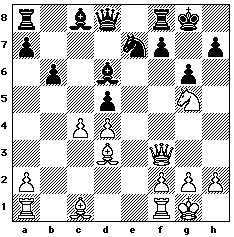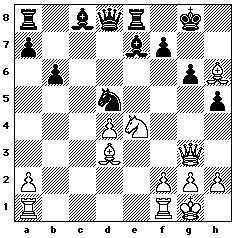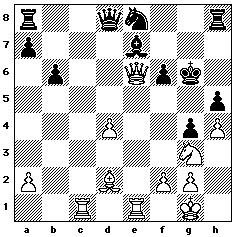
Jon and Bill are good friends. Both went to Princeton. They lived five miles apart. They both write for the APCT News Bulletin. Together, they teach chess to the children in central NJ. They share their completed postal games with each other. They eat Indian food together every Sunday. They even have the same opening repertoire. So what happens when two pals get paired?
Bill and I were paired in both the semi-final and final round of the 25th Anniversary Rook. For me, certainly, it was the pairing from Hell. Bill has the same opening repertoire, and his style is very much like mine. Not only that, for safety's sake, he keeps a copy of my games... and I keep a copy of his. There are no chess secrets between us.
In our semi-final game, we shied away from each other?s strengths and wound up in a line that neither of us have any claim to understand. I know that the Warrens picked up some extra cash selling their books to both of us!
1.e4
Expecting to play against a Hedgehog!
1...e5
JE: hmm. He blinks first! Not his usual Sicilian. Could it be that he has a surprise weapon ready?
2.Nf3
Not anxious to see his ideas in the Bishop's Opening, I blink second. Bill would have expected 2.Bc4, a move from my childhood that now carries with it a rather large body of personal experience. But Bill knows that I also have some recent experience with the Ponziani, thanks to David Taylor's manuscript.
2...Nf6
He blinks back! Now we're both on terra incognito. The following moves follow known theory, courtesy of Jim Warren's bookstore and the ever present Informants.
3.Nxe5 d6 4.Nf3 Nxe4 5.d4 d5 6.Bd3 Bd6 7.0-0 0-0 8.c4 c6 9.cxd5 cxd5 10.Nc3 Nxc3 11.bxc3 Nc6 12.Ng5
The first of several efforts to force weaknesses on the Black kingside.
12...g6 13.Qf3
JE: A recommendation from Ivanchuk in Informant 57. The pressure on the d-pawn freezes the Black queen and the idea of Qh3 keeps the Black bishop off the long diagonal. In addition, if Black tries ...Qa5, I can defend the c-pawn now by playing Bc2.
13...Ne7 14.c4 b6

Bill knows that I think that this is the losing move. I had expected him to try ...Qc7 or ...dxc4. ...b6 appears to be the appropriate tail end to the Rb1 b6 move pair, but I haven't yet committed my Ra1. My chess instincts tell me, therefore, to hold off on the development of the Ra1, to see whether it might more profitably develop elsewhere. ...b6 isn't all that weakening in itself, but if Black is intent on recapturing now on d5, he'll have to give my queen access to h3, which will itself result in further weakening of his kingside.
15.cxd5 Bb7 16.Qh3 h5 17.Ne4
JE: Nimzovitch would almost certainly approve. The knight move provides the Bc1 with access to the key dark squared weaknesses that have appeared on the kingside.
17...Nxd5 18.Bg5
JE: Certainly not 18.Bh6? Bc8 -+ Besides that, better first to force Black to retreat the Bd6.
18...Be7 19.Bh6 Bc8 20.Qg3 Re8

White's strategy is extremely simple. Over the next three moves, each threat will force Black to weaken the kingside further.
21.Qe5 f6 22.Qg3 g5 23.h4 g4 24.Bc4
The damage has been done. Now it's time to situate all the pieces as actively as possible. The light-squared bishop takes aim down the a2-g8 diagonal, the queen will assist it on b3, the knight gains an excellent outpost on g3, and the Bh6, if attacked, can retreat to d2 where it can maintain pressure upon the kingside without getting in the way of white's other pieces. Of course, through it all, I still haven't figured out what to do with the Ra1. I just know that it doesn?t belong on b1.
24...Kh7 25.Bd2 Bf5 26.Rfe1
26.Rae1 was also very tempting with the idea of f3 prying open the weakened structure.
26...Bg6
He wants to defend with ?Nc7 but first has to steal the f7-square from my Bc4.
27.Qb3
Augmenting the pressure on the a2-g8 diagonal.
27...Nc7 28.Bf7 Rf8
The Bf7 is clearly immune, and ...Qxd4 28.Bc3 is suicide.
29.Bxg6+ Kxg6 30.Ng3
White is extremely well coordinated and now threatens Qe3 and Nxh5, as well as Rac1.
30...Rh8 31.Rac1 Ne8 32.Qe6
Drawing upon one of the simplest chess principles. When your opponent gives up control over a square, move into it.

32...Ba3 33.Nxh5
Showing off. 33.Rc6 avoids the risk. The knight is immune, since 33...Rxh5 Qg4+, and 33...Kxh5 34.Qf5+ leads to mate.
33...Bxc1 34.Qxg4+ Kf7
On 34...Kg7 35.Qg4+ Kf8 36.Bb4+-
35.Qe6+ Kg6 36.Nf4+ Kh7 37.Qf7+ Ng7 38.Nh5 1-0
On his last card , Bill wrote: "Good game! See you in the '92 Finals!?" Amazingly enough, he was right!